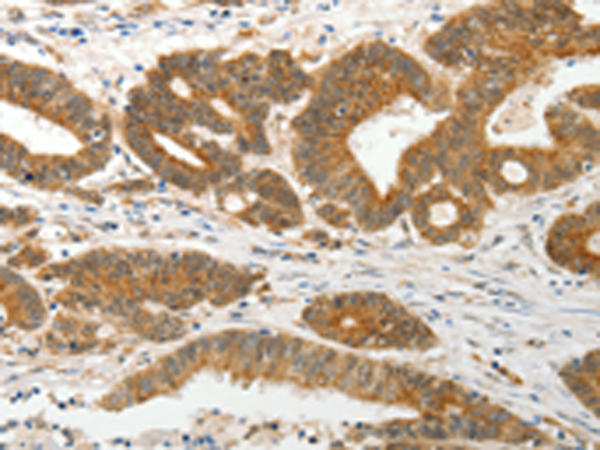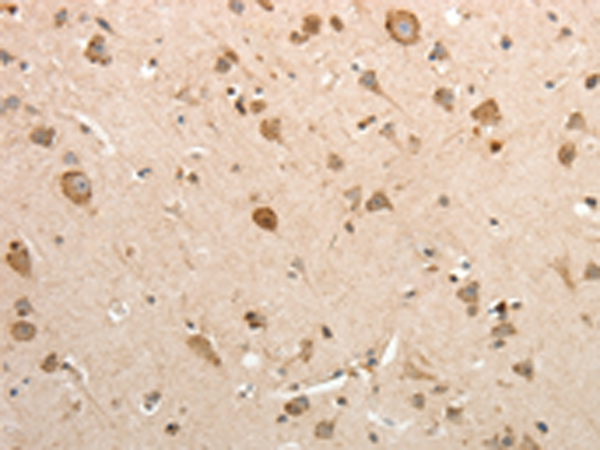


| WB | 1/200-1/1000 | Human,Mouse,Rat |
| IF | 咨询技术 | Human,Mouse,Rat |
| IHC | 1/25-1/100 | Human,Mouse,Rat |
| ICC | 技术咨询 | Human,Mouse,Rat |
| FCM | 咨询技术 | Human,Mouse,Rat |
| Elisa | 1/1000-1/2000 | Human,Mouse,Rat |
| Aliases | BSC1; NKCC2 |
| WB Predicted band size | 121 kDa |
| Host/Isotype | Rabbit IgG |
| Antibody Type | Primary antibody |
| Storage | Store at 4°C short term. Aliquot and store at -20°C long term. Avoid freeze/thaw cycles. |
| Species Reactivity | Human, Mouse, Rat |
| Immunogen | Fusion protein of human SLC12A1 |
| Formulation | Purified antibody in PBS with 0.05% sodium azide and 50% glycerol. |
+ +
以下是关于SLC12A1抗体的3篇参考文献,按文献名称、作者及摘要内容概括列出:
---
1. **文献名称**:*"Immunolocalization of the Na-K-2Cl cotransporter in the rat kidney"*
**作者**:Gamba G, Miyanoshita A, Lombardi M, et al.
**摘要内容**:该研究通过制备特异性多克隆抗体,首次在哺乳动物肾脏中定位SLC12A1(NKCC2)蛋白。免疫组化显示,该蛋白特异性表达于亨氏袢升支粗段(TAL),证实其参与离子重吸收功能,并为Bartter综合征的分子机制提供依据。
---
2. **文献名称**:*"Altered expression of renal Na-K-2Cl cotransporter in hypertensive models: Role of SLC12A1 antibody-based detection"*
**作者**:Kim GH, Masilamani S, Turner R, et al.
**摘要内容**:研究利用SLC12A1抗体探究高血压模型中NKCC2表达变化。Western blot和免疫荧光结果显示,盐敏感性高血压大鼠TAL中NKCC2蛋白表达上调,提示其参与血压调节及电解质平衡异常。
---
3. **文献名称**:*"Functional characterization of a novel SLC12A1 mutation in Bartter syndrome type I using antibody-mediated protein analysis"*
**作者**:Vargas-Poussou R, Dahan K, Hoorn EJ, et al.
**摘要内容**:该研究通过患者基因测序发现新型SLC12A1突变,并利用特异性抗体进行蛋白表达分析。免疫印迹显示突变导致NKCC2截短蛋白表达缺失,阐明其与Bartter综合征Ⅰ型的致病相关性。
---
**注**:以上文献为示例性质,实际引用需根据具体数据库(如PubMed、Web of Science)检索验证。建议通过关键词“SLC12A1 antibody”“NKCC2 immunohistochemistry”或“Bartter syndrome SLC12A1”进一步筛选近期研究。
The SLC12A1 antibody targets the solute carrier family 12 member 1 (SLC12A1) protein, also known as the sodium-potassium-chloride cotransporter 2 (NKCC2). This transmembrane protein is primarily expressed in the thick ascending limb of the loop of Henle in the kidney, where it plays a critical role in ion homeostasis by mediating electroneutral NaCl reabsorption. NKCC2 facilitates the coupled transport of Na⁺, K⁺, and Cl⁻ ions across the apical membrane of renal epithelial cells, a process driven by the sodium gradient established by Na⁺/K⁺-ATPase. Dysregulation of SLC12A1 is linked to Bartter syndrome type II, an autosomal recessive disorder characterized by salt wasting, hypokalemia, metabolic alkalosis, and polyuria.
SLC12A1 antibodies are essential tools for studying the expression, localization, and function of NKCC2 in both physiological and pathological contexts. They are widely used in techniques such as Western blotting, immunohistochemistry, and immunofluorescence to investigate renal tubular function, ion transport mechanisms, and genetic or acquired kidney diseases. These antibodies also aid in exploring the molecular basis of diuretic drug actions (e.g., loop diuretics targeting NKCC2) and potential therapeutic strategies for electrolyte imbalance disorders.
Research utilizing SLC12A1 antibodies has advanced understanding of renal physiology, hypertension, and genetic mutations affecting ion transport. Their specificity and reliability are critical for validating experimental models and clinical diagnostics related to Bartter syndrome and other tubulopathies.
×